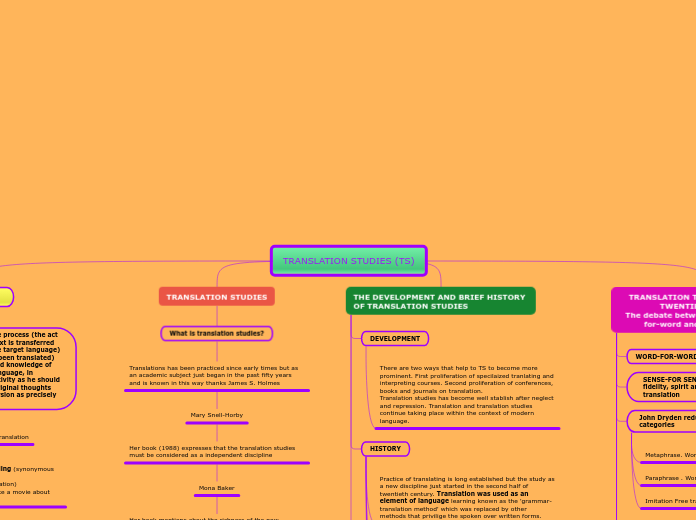TRANSLATION STUDIES (TS)
Make a weekly plan, fill in each task and then check them off as the week advances.
TRANSLATION THEORY BEFORE THE TWENTIETH CENTURY
The debate between translation word-for-word and sense-for sense
Monday
A fresh start, a clean slate, and a lot of potential for great things to come. That is what Mondays really are!
Begin your week with a good plan in mind and follow the guidelines to organize the week ahead.
https://www.routledge.com/Introducing-Translation-Studies-Theories-and-Applications/Munday/p/book/9781138912557l
Schleiermacher was the first in distinguishing two different types of translator working on two different types of text
1. The Dolmetscher who translates comercial texts
2. The ubersetzer who works on scholarly and artistic texts
TYTLER has three general laws or rules
1. The translator should give a complete transcript of the ideas of the original work
2. The style and manner of writing should be of the same character with that of the original
3. The translations should have all the ease of the original composition
Etienne Dolet sets out five principles in orden of importance
1. The translator must understand the sense and material of the original author
2. The translatorshoul have a perfecto knowledge of both languages
3. The translator should avoid word-for-word
4.The translator should avoid Latinate and unusual forms
5. The translator should assesmble words eloquently
John Dryden reduces all translation to three categories
Imitation Free translation (adaptation)
Paraphrase . Words are no strictly followed as their sense
Metaphrase. Word by word and line by line
SENSE-FOR SENSE. Here hte translation has fidelity, spirit ans truth all of this makes a free translation
WORD-FOR-WORD. Here the translation is Literal
THE DEVELOPMENT AND BRIEF HISTORY OF TRANSLATION STUDIES
Wednesday
Wednesdays are like Mondays in the middle of the week, they say. You're halfway through the week, see what plans you have set for today.
HISTORY
The Holmes map. Holmes map described what translation studies covers. 1. The description of the phenomena of translation (Descriptive translation theory) 2. the establisment of general principles to explain and predict (Translation theory)
The applied branch of Holme's framework
Translation criticism (evaluation of translations)
Translator aids (dictionaries, grammars and information
technology)
Translator training ( teaching, methods, testing, techniques, curriculum design)
Pure
Results of Descriptive translation studies, refers to partial theories of translation
Problem-restricted theories can refer to specific problems
Time-restricted they are theories and translations limited according to specific time frames ans periods
Text-type restricted theories look a specific discourse types or genres
Rank-restricted theories are linguistic theories have benn restricted toa specific level of the worl sentence
Area-restricted theories are restricted to specific language (s) and/or cultures
Medium-restricted theories, subdivide according to translation
By humans
Spoken
Written
By machines
As an aid of human translator
Machine/computer is working alone
Descriptive translation studies (DTS) has three possible foci of examination:
The process is concerned with psychology (what happened in the mind of the translator)
The function is the study of the context when the book was translated
The product. examines existing translations, accordin to the time we can find
Synchronic (at a single point or period in time)
Diachronic (Following development over time)
Theorical
Partial Theories. The studies are restricted according to parameters
General Theories. Translation as a whole
Contrastive analysis. The study of two languages to find differences between them and incorporate sociocultural and pragmatic factors.
Comparative literature would be later the link into the growth of courses of the cultural studies type
The translation workshop, based on I.A. Richard's reading workshops, they were a platform for the introduction of the tranlation process of undestanding a text
Practice of translating is long established but the study as a new discipline just started in the second half of twentieth century. Translation was used as an element of language learning known as the 'grammar-translation method' which was replaced by other methods that privilige the spoken over written forms.
DEVELOPMENT
There are two ways that help to TS to become more prominent. First proliferation of specilaized tranlating and interpreting courses. Second proliferation of conferences, books and journals on translation.
Translation studies has become well stablish after neglect and repression. Translation and translation studies continue taking place within the context of modern language.
TRANSLATION STUDIES
What is translation studies?
Translations has been practiced since early times but as an academic subject just began in the past fifty years and is known in this way thanks James S. Holmes
Mary Snell-Horby
Her book (1988) expresses that the translation studies must be considered as a independent discipline
Mona Baker
Her book mentions about the richness of the new discipline 'Translation studies'
TRANSLATION
DEFINITION It can refer to the process (the act through which the content of a text is transferred from the source language into the target language) or the product (the text that has been translated)
The translator needs to have good knowledge of both the source and the target language, in addition to a high linguistic sensitivity as he should transmit the writer's intention, original thoughts and opinions in the translated version as precisely and faithfully as possible.
Jakobson´s categories of translation
Intralingual translation or rewording (synonymous in the same language)
Interlingual translation (the translation)
Intersemiotic translation (like make a movie about the text)
References
Join Translation Journal
https://translationjournal.net/October-
2017/definition-of-translation.html
https://www.routledge.com/Introducing-Translation-Studies-Theories-and-Applications/Munday/p/book/9781138912557

